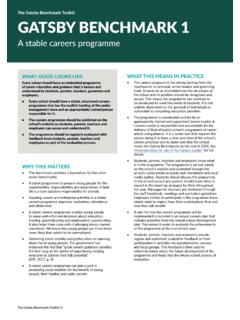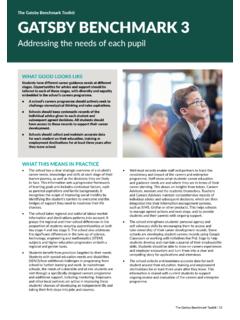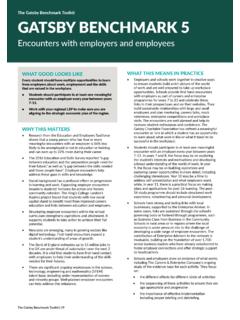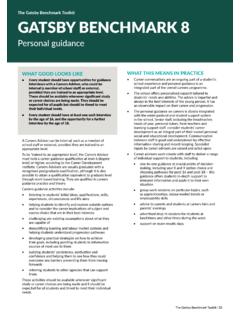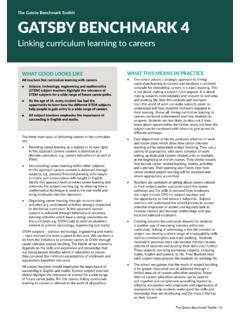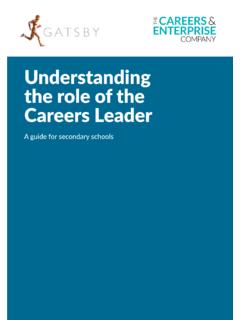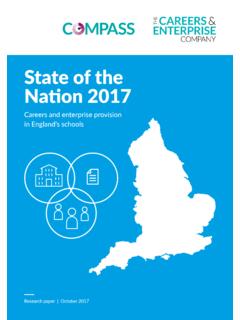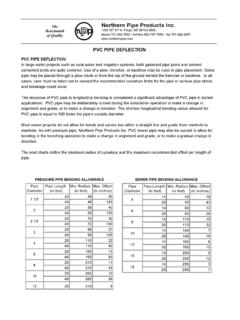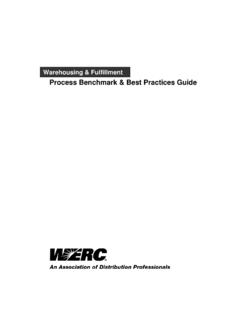Transcription of The Gatsby Benchmark Toolkit GATSBY …
1 The GATSBY Benchmark Toolkit | 8 The GATSBY Benchmark ToolkitGATSBY Benchmark 2 Learning from career and labour market informationWHAT GOO D LOOKS LIKEAll students and parents should have access to high-quality information about future study options and labour market opportunities. They will need the support of an informed adviser to make best use of available information. By the age of 14, all students should have accessed and used information about career paths and the labour market to inform their own decisions on study options. Parents should be encouraged to access and use information about labour markets and future study options to support their children. WHAT THIS MEANS IN PRACTICE Students are taught how to find and process information from year 7 onwards. They use objective information about the local and national labour market to make decisions that improve their careers and transitions into work.
2 Students have access to accurate and up-to-date information, which plays a key role in raising aspirations and promoting social mobility. This information challenges stereotypes with regional and national LMI and support from Local Enterprise Partnerships (LEPs). Information is adapted to meet the needs of different learners. Special schools, for example, make good use of Makaton signs and symbols to support understanding of careers and employability for students with severe learning and communication difficulties. The careers information area is attractive, highly visible and contains carefully-selected resources that meet the needs of different groups. The area should be properly maintained, well-used and include a mix of printed information (careers books, posters, prospectuses), online resources (dedicated careers pages on the website and/or Virtual Learning Environment VLE) and in-house information (options booklets, alumni profiles, projects) to help students understand the range of different opportunities.
3 Appropriately trained staff are on hand to offer students practical help with researching opportunities and using the resources. The staff should use social media to reach students and their parents and provide personal advice and guidance, particularly to students with intensive information needs. Your school arranges for students to gain information first-hand through encounters with employers and experiences of workplaces. Staff organise follow-up activities in the classroom to help students to personalise and maximise the benefits of these encounters. Local Enterprise Partnerships produce local labour market information to help students, parents and staff understand the changing labour market in their area. These resources are actively promoted by schools on their websites and at events, such as parents and Labour Market Information (LMI) includes information on: skills, career pathways and progression routes in the local labour market job applications and interviews educational institutions, courses, qualifications, entry requirements and costs professional bodies employment sectors, employers, jobs, salaries and employment trends jobs, training and apprenticeships job demands and working life financial planningThe GATSBY Benchmark Toolkit | 9 The GATSBY Benchmark ToolkitGATSBY Benchmark 2 Learning from career and labour market informationTOP TIPS FOR EMPLOYERS1.
4 Check out the sources of information that the school promotes to its parents and students as part of your Share additional insights, sources and contacts from your own sector and from your LEP so that teachers, Careers Advisers and students have a more rounded picture of Provide references to good sources of information as part of employer engagement Encourage students to undertake follow-up research so that they can find out more and start to put plans into Provide practical examples of how different subjects are used within the workplace so that students value the skills and knowledge they are developing at Illustrate your talks with film clips or job profiles from free careers resources, such as I Could or the National Careers Service. 7. Bring talks to life with concrete case studies that show diverse pathways and job opportunities in your organisation.
5 You should also provide your organisation s websites with details of entry Share your insights into trends in the labour market as part of your contribution but encourage students to do their own research Contribute to the training of teachers and Careers Advisers about changes in the labour market to ensure those working directly with students on a day-to-day basis are Listen to what young people say about careers information and share these insights with schools and the Enterprise Adviser Network to support ongoing improvement in the impact of careers TIPS FOR SCHOOLS1. Check that you are making good use of resources available through your Local Enterprise Partnership, via the Enterprise Adviser Review your website and learning resource centre to ensure they cover all routes and engage the interests of students and parents. Share these key sources with link employers so that your students receive consistent messages.
6 Involve users in feedback about the value and impact of the career and labour market information on offer. 3. Start early so that young people and their parents have a good amount of time to explore opportunities and build full and realistic pictures of the job Ensure events and parents evenings explain and promote the full range of opportunities in an impartial way, including emerging technical levels. This should also include information about local University Technical Colleges and studio schools to support decisions at the 14+ level. 5. Draw on JobCentre Plus schools advisers to come in to talk to pupils, parents and staff about local LMI and apprenticeships. Your Enterprise Adviser and Enterprise Coordinator will provide local contact details. 6. Train older students to support younger colleagues to make use of key careers information Make use of a wide range of media to encourage students in their career exploration including social media, posters, websites and physical resources.
7 Develop a careers assembly plan that identifies careers information topics appropriate for each year THIS MATTERS Access to up-to-date career and labour market information is important for social mobility. Information about pay, numbers of vacancies and alumni s successful transitions helps to connect students to a different future. Students with high aspirations often lack the knowledge to put their plans into action. Providing detailed information about progression routes, relevant courses and employers and useful networks strengthens their capacity to make effective choices and transitions. Students, parents and teachers need to be updated about new and developing routes and pathways, such as technical levels in occupational areas and the continued expansion of apprenticeships. Students need strong digital skills to make good use of online information about career exploration, making applications, self-presentation and professional GATSBY Benchmark Toolkit | 10 The GATSBY Benchmark ToolkitGATSBY Benchmark 2 Learning from career and labour market informationEXAMPLE RESOURCES Connect with your Enterprise Adviser or Enterprise Coordinator to access local information including encounters with employers and experiences of workplaces.
8 See how some of the 800 job profiles on the National Careers Service site can help illustrate careers activities and offer online guidance for young people. Obtain the labour market summaries for your LEP area. These will provide useful information on major employers and sectors and developing trends. LMI for All is an online data portal that connects and standardises existing sources of high quality, reliable LMI. You can make use of the customisable Careerometer Widget for your school website. Nomis is your one-stop shop for labour market information. The summary pages provide key trend data about a local area. I Could provides 1,000 different video clips of LMI and personal career stories to help students explore different career routes and pathways. Get In Go Far is the government portal for information about apprenticeships, with a linked website to find live apprenticeship vacancies.
9 Amazing Apprenticeships provides ideas from Apprenticeship Champions on how to promote apprenticeships. The site also provides free talks and guidance to schools via the Apprenticeship Support Knowledge service (ASK). National Careers Week provides a range of posters, inspirational quotes and links to the Royal Bank of Scotland Kickstart resources. This government tool allows you to use your postcode to search for courses and qualifications available in your local area. Higher Education Funding Council for England helps you identify the Single Points of Contact in your Higher Education Networks, along with local outreach events such as summer schools and advice and information on progression. Prospects Education Resources keeps you up to date on new and popular costed careers resources, posters and software. Career Companion is an independent and impartial guide to careers information on the internet (subscription required).
10 Federation for Industry Sector Skills & Standards provides free, sector-specific careers information for young people through the network of Sector Skills Councils (SSCs).The GATSBY Benchmark Toolkit | 11 The GATSBY Benchmark ToolkitGATSBY Benchmark 2 Learning from career and labour market informationExample 1 Ellowes Hall School, an 11-18 secondary school in Dudley, recently undertook a wholesale revision of the careers section of its website. Sixth-form students took the lead on the design and construction of the website and through extensive consultation with all year groups, ensured that the content on the site met students needs. The updated site provided relevant labour market information on a wide range of career sectors tailored to the interests of students, such as current vacancies. Beyond the website, the school also has a Careers Adviser who makes time to support students with individual OF GOOD LEARNING FROM CAREERS AND LABOUR MARKET INFORMATIONE xample 3 Ofsted recently praised an outstanding central London school for the fact that its students receive excellent advice about their career options, training and employment opportunities from year 7 onwards.
